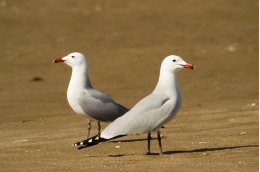15-05-2020
Seabirds and fisheries: a challenge for the protected marine area management
Photo:Raül Ramos (UB-IRBio)
Audouin’s gull (Ichthyaetus audouinii), an emblematic marine area in the Mediterranean which winters in north-western African coasts, is specially threatened by bycatches, dependence on fishermen’s discarding and pollution in the marine environment. Despite the improvements in the conservation of this bird since the eighties, this is now a vulnerable species at a national scale due to the drastic reduction of its population in the Ebro Delta (Tarragona) and the occupation of highly transformed environments by the human activity.
Audouin’s gull (Ichthyaetus audouinii), an emblematic marine area in the Mediterranean which winters in north-western African coasts, is specially threatened by bycatches, dependence on fishermen’s discarding and pollution in the marine environment. Despite the improvements in the conservation of this bird since the eighties, this is now a vulnerable species at a national scale due to the drastic reduction of its population in the Ebro Delta (Tarragona) and the occupation of highly transformed environments by the human activity.
A 90% of the world nesting population is found in Spain, especially in the protected spaces by the current regulation. This is why, improving the management of the Spanish Network of Marine Protected Areas (RAMPE) is a determining factor for those marine birds that are threatened by fishery interaction.
A new project named “La gaviota de Audouin como instrumento para la mejora de la gestión de la RAMPE en el Levante español-GAUDIN”, will analyze the value of these protection figures in the conservation of marine biodiversity and in particular, marine birds. The project, to be finished in March 2021, is supported by the Biodiversity Foundation from the Ministry for Ecological Transition and Demographical Challenge, and is led by Professor Jacob González-Solís Bou, head of the Group on Ecology of Marine Birds at the Department of Evolutionary Ecology and Environmental Sciences, and member of the Biodiversity Research Institute (IRBio) of the University of Barcelona.
Young and adult gulls: are there any differences in their use of marine space?
This new initiative to protect the biodiversity in the country will determine the level in which the distribution of the Audouin’s gull coincides with the RAMPE area, as well as factors that modulate the interaction between these birds and the fishing fleet in and outside of the protected spaces. For the first time, the project will study the differential response of gulls to the interactions and bycatches depending on the age of the individuals, “so that we can compare the use of the marine space and interactions with fisheries of the young and adult Audouin’s gull”, notes Raquel del Castillo Contreras, scientific coordinator of the project and researcher at the Department of Evolutionary Biology, Ecology and Environmental Sciences.
The scientific team will study the movements of Audouin’s gull in the Peninsular Levantina using global positioning system devices (GPS-GMS) in five individuals of the Parque Regional Salinas y Arenales de San Pedro del Pinatar (Murcia), one of the breeding areas of this species. To understand how and why the gulls interact with fishing boats, the obtained data of the birds will be combined with the monitoring of the fishing fleet via satellite using the VMS system, the AIS system and GPS devices.
The new project, with the collaboration of the Southwestern Association of Naturalists (ANSE) and the Spanish Institute of Oceanography (IEO), counts on the participation of the researchers Marta Riutort, from the Department of Genetics, Microbiology and Statistics and IRBio, and Sarah Saldanha and Leia Navarro, from the Department of Evolutionary Biology, Ecology and Environmental Sciences of the UB.
Source:PressUB
Source:PressUB
